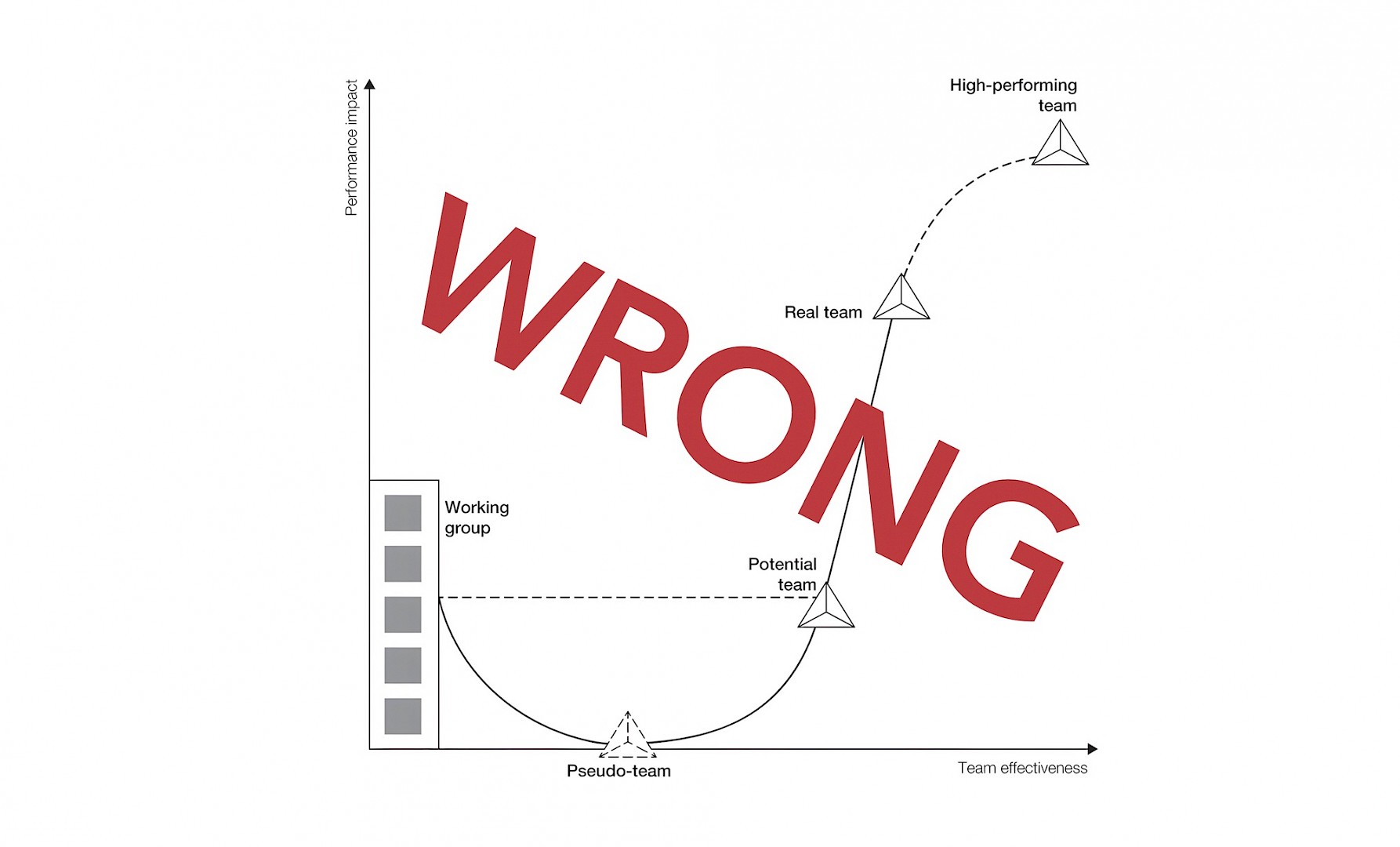Forget Katzenbach's Team Performance Curve
9.9.2023 — Time to retire this dangerously misleading picture! It incorrectly presents teamwork as an optional luxury, hopefully achieved after a slump in performance.

1993 consultants Katzenbach and Smith went to organizations, observed 47 teams, and wrote a book, "The Wisdom of Teams: Creating the High-Performance Organization." The book gives common-sense advice and a story to support each piece of advice. The writers visualized their findings as a "Team Performance Curve," as seen in the title image. We will only comment on the Curve and let serious readers judge the book themselves.
The book is a child of its time. Itwas written soon after the Lean literature started to praise the superior Japanese quality and efficiency, where Teamwork plays an essential role. The Lean enthusiasm caused a team fad in the West, which was soon eaten by the culture. Some landmark research on Teamwork, for example by Hackman and Wheelan, had yet to be published, and the never fully proven Tuckman's model was still alive.
The Curve still floats in social media, so we wanted to explain it and give some pointers for updated knowledge.
Interestingly, like several other authors, the writers note at the book's opening that high-performing teams are rare. Their emphasis on pseudo-teams implies that bad collaboration is embarrassingly common.
The Curve (and the book) present some valid points:
-
According to Katzenbach himself, "In a nutshell, the wisdom of teams (the book) is they focus on performance rather than togetherness." (https://www.ideaconnection.com/interviews/00074-Performance-Rather-than-Togetherness.html) We agree. Teamwork is a strategy to get the work done, so performance is the primary measure.
-
Teams happily doing the wrong thing is a common dysfunction. Yes, and other significant dysfunctions exist.
-
When your organizational design relies on self-managing teams and empowering the front line, you need to ensure the essential conditions for Teamwork. Yes, but the Curve and the book wrongly frame this as "teamwork (collaboration) is an optional add-on." Hackman's research has clarified this well, and Katzenback even recommends him in the above-mentioned interview, given a decade later.
But. There are too many confusions and false assumptions:
-
The Curve may look scientific, but is not. The points through which the curve goes are typologies that represent the writer's sense-making. The supporting data is anecdotal.
-
The x-axis ...have you ever checked... is team effectiveness, chosen to differentiate "performance" from "togetherness." Even when you read carefully, it takes some effort to digest. Both axes are difficult to measure in real life, so the applicability of the Curve remains unclear.
-
The "stages" of the teams: working group, pseudo-team, potential team, real team, and high-performing team are the writers' version of team development, probably inspired by Tuckman's *orming. In reality, there are numerous possible paths, patterns, and end states. This can not be compensated by the dotted line providing an alternative path.
-
The Curve is completely made up. A normal team does not go through a performance slump, a "hero's journey." It just continuously learns to work and collaborate, with some stops for problem-solving. Trying to promote teamwork with this picture will do more harm than good.
-
Pseudo-teams are just one reason for bad performance. For example, teams may unhappily underperform when lacking the right people, resources, clear goal, or other essential conditions. The Curve disregards these other common dysfunctions that, by the way, also plague the "working groups."
-
Few pseudo-teams can recover to performing teams with a reasonable effort. When the work is thought to be too difficult or unreasonable, the team (and/or the surrounding org) accepts fake results under high pressure. The underlying reasons are real and require major actions to improve. A team typically lacks the essential conditions or develops chemistry problems. A team may even have a fake goal set up to cover incompetence somewhere else.
-
Different teams end up with different performances or dysfunctions, depending on the skills and conditions, not because of adding "teamyness" on top.
-
Keeping a team as a "working group" in practice makes it manager-driven, which makes the manager the bottleneck. This, however, does not prevent dysfunctions, as the writers propose! It is not possible to avoid group dynamics.
Every, every group tries to collaborate. Depending on the skills and context, the collaboration will be excellent, bland, or dysfunctional. Leading teamwork is an essential skill for every manager and influential team member, also in a manager-driven "working group."
Where to look instead?
Richard Hackman did 40 years of research on teamwork at Harvard. His 2005 landmark book is the primary source for building teamwork. If your teams are more dynamic, his later 2011 book is valuable.
To understand group development, the team's growing into a one solid team, read our blog first. For more detailed advice look for Susan Wheelan's work.
According to Hackman, 60 % of the success comes from creating the right organizational conditions, 30 % at the launch, and 10 % from coaching while working. At the launch people check if they can trust in:
- How will I be treated?
- Will others do their part?
- Are we going to survive (succeed)?
For more about trust and safety, please look at Google's ReWork research.
Finally, decades of research by Deci et al. say that intrinsic motivation comes from competence, autonomy, and relatedness.
Join our training to learn more and see through fancy theories that seem to make sense.

